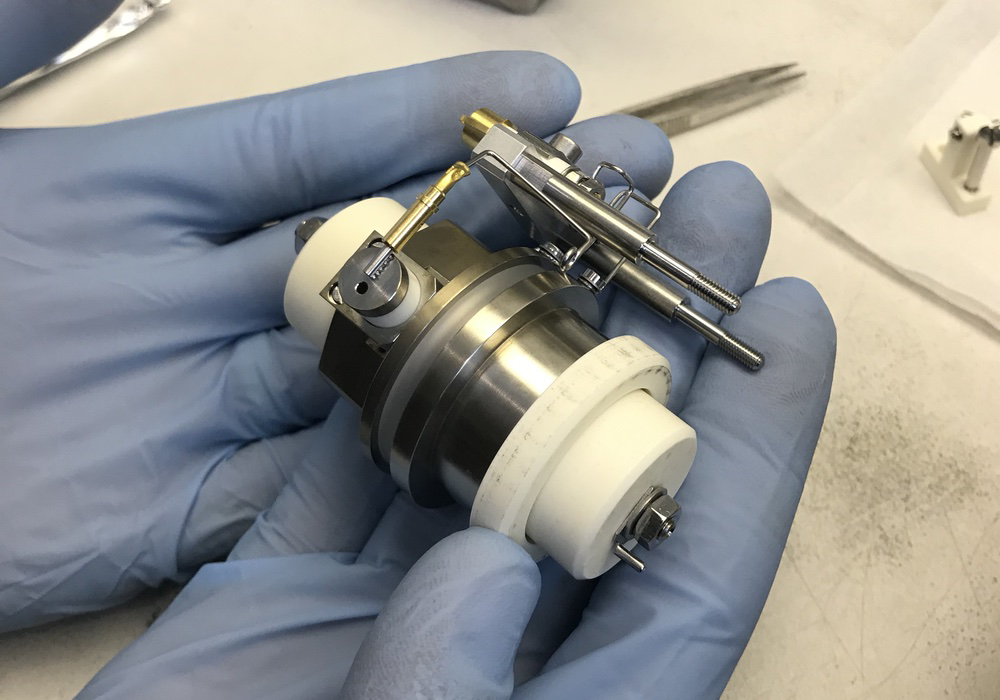A Tiny Laser Device Could Reveal Alien Life
Signs of extraterrestrial life could be found close to our home on Earth. Researchers have hypothesized that the remains of long-dead microbes could exist within the crust of Mars and that microbial life could be thriving in the plumes of methane being expelled on Saturn’s moon Enceladus. To detect those signatures, researchers would need an instrument that can precisely identify complex organic molecules, biogenic minerals, and other biomarkers. Such an instrument would also need to be compact and lightweight, allowing for it to be blasted into space before moving onward to another planet.
Lori Willhite, a graduate student at the University of Maryland, College Park, and her colleagues have now made a miniaturized laser device that fits the bill [1]. Developed at the NASA Goddard Space Flight Center in Maryland, the device uses an Orbitrap analyzer—a type of mass spectrometer that became commercially available for use in analytical laboratories in the early 2000s. In recent years, researchers have recognized the Orbitrap’s potential for applications in space exploration. However, at the size and weight of a household fridge, the Orbitrap is too bulky for space missions.
To make the analyzer amenable to astrobiology initiatives, the team drastically reduced the mass and volume of the Orbitrap by removing parts of the analyzer that are needed for laboratory experiments but not for space ones. In a lab, for example, a large pump is needed to keep the instrument at the low pressure it needs to function. But Mars and Enceladus lack substantial atmospheres. “The instrument is already going to be at the right pressure,” Willhite says.
Through their changes, Willhite and her team brought their Orbitrap’s mass down from 400 pounds, or 180 kilograms, to 17 pounds, or 8 kilograms. The team performed laboratory tests of the new instrument on materials ranging from simple salts to more complex organic molecules such as chlorophyll. These tests show that the miniaturized device works on par with the full-sized version and can take measurements of molecular mass that reveal the structures of such compounds.
“[The Orbitrap] really just enables more robust measurements and, I think, more definitive measurements than we’ve been able to do thus far,” says Amy Hofmann of NASA’s Jet Propulsion Laboratory in California. Her own research involves lab-based analyses of rare isotopes using a full-sized Orbitrap. According to Hofmann, the Orbitrap has a higher mass-resolving power than almost any other mass spectrometer, making it a practical choice for identifying complex organic molecules with masses that differ by minuscule amounts . She says that in order to prepare the new Orbitrap for a mission, Willhite and her colleagues should continue to develop the device’s ability to look at complex mixtures of decreasing concentrations. “Let’s push it to the limit and see where the signal is lost in the noise,” Hofmann says.
The team is looking at potential uses for the instrument on both an orbiting mission and on a landing mission, where it would likely be attached to a rover. Willhite would particularly like to see the instrument go to the Moon, where it could reveal details of the formation of Earth’s closest neighbor. According to Willhite, there are a couple of spots on the lunar surface that are unusually high in silica. Using the device to find out why would be interesting, she says, and exciting.
–Allison Gasparini
Allison Gasparini is a freelance science writer based in Santa Cruz, CA.
References
- R. Arevalo et al., “Laser desorption mass spectrometry with an Orbitrap analyser for in situ astrobiology,” Nat. Astron. (2023).





